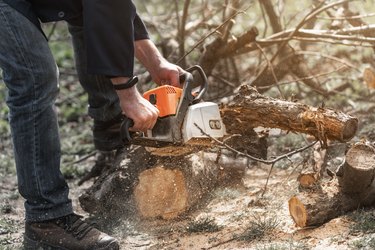
A chainsaw clutch uses centrifugal force to turn the chain. The outward pressure forces the clutch and chain to spin. Sometimes you may encounter problems when the chainsaw blade not turning or not being able to stop the chain from turning. If the chain continues to turn even when it's not throttled, put on the safety brake and correct the problem. This poses an extremely hazardous situation for the cutter should they fall or drop the chainsaw.
Engaging the Clutch
Video of the Day
Most chainsaws idle at around 2,800 to 3,200 revolutions per minute, or RPMs. At this speed, the crankshaft continues to spin, but the clutch doesn't. When the trigger is pressed and the engine speeds up, the force pushes outward on the clutch. A drive on the clutch hooks onto the drive sprocket and starts turning the chain. When the trigger is released, the chainsaw drops back to idle speed. As the chainsaw idles, the crankshaft is no longer spinning fast enough to turn the chain, and you should see that the chainsaw chain is not moving.
Video of the Day
Carburetor Adjusting Screws
The carburetor inside most chainsaws regulates the three different engine speeds. The speeds are controlled by the amount of gas flowing in at that given speed. Three screws on the carburetor wall open or close vents inside the carburetor. This, in effect, increases or decreases the amount of gas available for combustion at the given speed. When the chain spins while idling, the engine is idling too high—getting too much gas at idle speed—for the chain to come to a stop.
Before Adjusting the Carburetor
To stop the chain from turning while idling, the idle speed screw must be reduced to decrease the flow of gas. Adjusting the carburetor can be a tricky process for the uninitiated, and improper adjustment can cause serious damage to the engine. If the gas is increased, the engine will burn too hot and cause damage around the cylinder and piston seals and gaskets.
This damage can be expensive—if not impossible—to repair on some machines. Also, adjusting the carburetor yourself can void the manufacturer's warranty. Consider whether this is something you want to tackle yourself or if it may be better to contact the manufacturer for repairs.
Adjusting the Carburetor
While many chainsaw manufacturers want the chainsaw to be taken to a professional for carburetor adjustment, as this reduces warranty claims for them, adjusting the carburetor is quick and simple once you know how. Always clean the air filter and the area around the air filter before adjusting the carburetor. Make sure you dump out any old gas or bad gas and fill the tank with freshly mixed two-cycle fuel. Let the engine warm-up before making adjustments.
Most chainsaws have three holes on either the left or right side of the engine that give access to the carburetor adjusting screws. Insert a small screwdriver into the hole marked "LA," "I" or "T," which are common on many saws for the idle speed screw. Turn the screw slowly counterclockwise until the chain stops spinning. Don't adjust the low or high speed screws without professional help.
Once you have completed the adjustments, check that the repair was successful. When idling, you should see that the chainsaw blade is not moving.